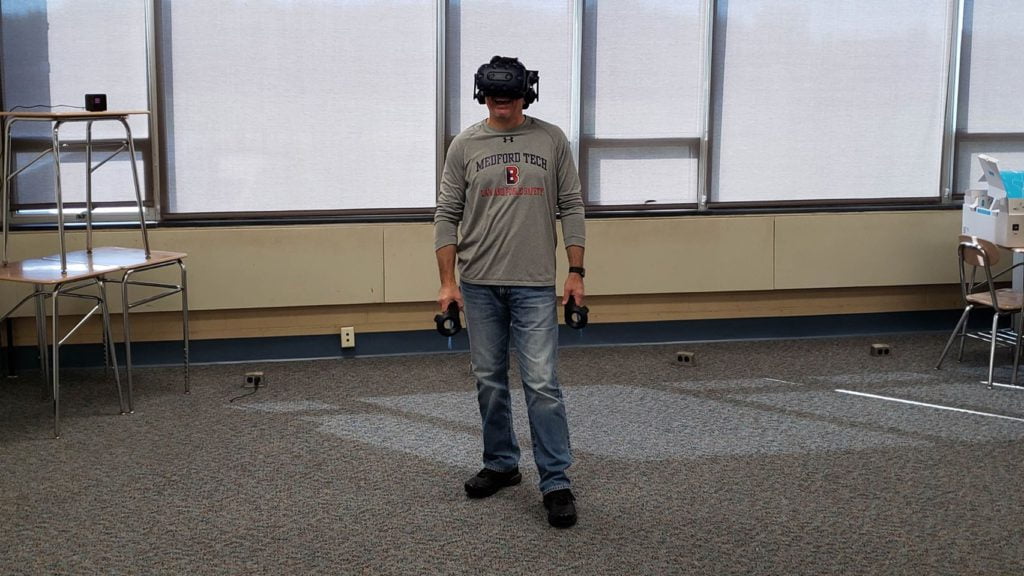Back to Envision XR
Envision Featured in NJSBA article: Bringing the Future to the Present
Immersive Technologies: Shaping the Next Generation of Teaching and Learning
NJSBA Work Based Learning- A Critical Opportunity for All Students
Forensic Science
Burlington County Institute of Technology (BCIT) has two campuses located in Medford, NJ and Westampton, NJ which both feature law and public safety departments with forensic science laboratories. Each campus laboratory utilized a standalone room to physically simulate a crime scene with mannequins and various pieces of fake evidence. The forensic science instructors informed us of their disappointment with how unauthentic the crime scene simulation was. They mentioned specifically that the mannequins did not have realistic wounds and that the floor, walls and ceiling did not simulate enough real-world distractions like a forensic investigator would encounter in the field. Envision took strong note of these problems and proposed a VR solution to eliminate such.
Envision developed ten ultra-realistic environments ranging from urban to suburban to rural in theme both day and night. We implemented real audio to ensure real-life distraction. Our urban environments, for example, contain background noises like automotive traffic and horns. We implemented realistic virtual murder victims with grotesque stab wounds. Our intention was to shock and desensitize the forensic science trainee so that they are better prepared for encountering the real thing in the field. The BCIT forensic science instructors have greatly appreciated this. We developed a user-friendly menu interface with a “bag of forensic science tools” for the student user to utilize in each VR crime scene. Once a student user selects their crime scene environment, they must take proper-angle photos of the scene, victim, and wounds with a VR camera. They must collect all pieces of evidence and store them in proper evidence containers. For example, wet evidence must be stored in a paper bag vs. dry evidence that must be stored in a plastic bag. We created official weapons containers for the student user to place knives and guns into. We implemented haptic feedback into the VR controllers to make tracing bodies with chalk and unrolling crime scene tape more realistic. This functionality adds a significant layer of realistic depth to our crime scenes.
Once the student user collects all evidence and obtains all necessary photos they leave the VR crime scene and enter the VR forensic crime lab. In the lab they process all evidence, view the photos they captured on an emulated VR computer, utilize ultraviolet flashlights to view fingerprints and biological fluid, and ultimately send evidence out to appropriate additional labs for processing. When the student exits the forensic crime lab their entire experience including photos taken are viewable by the instructor for post-exercise review, discussion and grading. The following app footage videos represent the VR (left or top) and mobile app (iOS & Android – right or bottom) solutions we developed for BCIT’s Law and Public Safety program, specifically for their forensic crime investigation courses.
Envision is proud to announce that we’ve recently expanded our Forensic EduSim™ platform into the Mercer County Technical School curriculum.
Art & History

Envision developed an Augmented Reality (AR) application, Who Are the People?, for the US Architect of the Capitol which brings the statues of Emancipation Hall to life in anyone’s smartphone or tablet anywhere in the world. The AR statue experiences teach about the art, history, life, and legacy of each statue represented in the application—of diverse American heroes whose stories are largely untold. We’re currently expanding the experience for the US Architect of the Capitol by another 8 statues in addition to the original 6. You can view the official launch press release for Who Are the People? here and download the app from either the Apple App Store or Google Play store:
Medicine & Health
After extreme customer satisfaction with the Virtual Reality (VR) forensic simulator, Burlington County Institute of Technology (BCIT) approached Envision about their Allied Health and Sports Medicine programs. They expressed the lack of intelligent medical simulation due to shortage of instructors and limited student-sharing time with the medical mannequins. In response Envision proposed a medical triage simulator that covered both existing medical conditions for allied health as well as common injuries seen in sports medicine. We developed a three phase VR application which first includes an intelligent conversation with the patient. There are certain questions that needed to be asked like “Are you allergic to anything?” for example. We included the necessary questions but also incorporated more specific questions to help the student user drill down on a pre-diagnosis. Therefore, the first phase of our triage simulator includes an intelligent conversation with an avatar patient.

The second phase of our triage simulator includes using interactive VR medical tools such as a thermometer, blood pressure cuff and pulse oximeter. The third phase of our medical triage simulator askes the student user to make a pre-diagnosis based on the initial conversation and vitals obtained from the VR medical tools. Once the student user makes a choice, everything is logged for post-exercise assessment, review and grading. We developed 10 medical conditions and common sports injury scenarios featuring grotesque wounds and injuries to better prepare the student. We also applied normal medical office distractions such as garbled conversation from the examination room next door and footsteps in the hallway. We tried to provide the student user with every distraction and potentially horrific wound visual they would encounter in the actual profession. The following app footage videos represent the Medical Triage Simulator (left) and Human Anatomy (right) VR solutions we developed for BCIT’s Allied Health and Sports Medicine programs.


Chemistry
Hamilton Buhl is a leader in the design and manufacture of electronics and presentation equipment for education and industry. They approached Envision about creating virtual classrooms of the future. We developed a MR chemistry classroom experience that allows VR users to experience the classroom in first-person and AR users to experience it in third-person. This technology is very simulator to the active shooter response trainer in the sense that anyone can hop into the collaborative and platform-agnostic MR experience. The application first askes each user to input their name as users join the waiting lobby. Once there are at least a few users in the waiting lobby the experience can be launched by any student. The VR user is placed in an actual classroom where the content appears in the front of the classroom. The AR user simply has to point their smartphone or tablet at a flat surface to launch the experience. Students are shown the molecular composition of common elements and compounds. All students see the same display and must choose the correct answer. For example, if they see the molecular composition of a diamond then they must choose the image showing a diamond. The experience waits for all students in the experience to make a selection before moving on to the next element or compound. The application records how long it takes each student to make their selection. At the end of the experience the students are ranked on a scoreboard based on their average time making a selection.
Envision then took the chemistry classroom of the future concept to a higher level with a standalone VR application for the Oculus Quest. Envision saw the opportunity to utilize innovative interaction with the periodic table of elements. We created two modes, learning mode and quiz mode. Learning mode allows you to pull any element from the period table into your hand by simply reaching out towards it. Quiz mode steps students through an interactive quiz where the atomic structure of an element is displayed, and the student must choose the correct element by name. What makes this application so unique is that the user can use their bare hands to interact with the VR experience rather than having to use physical VR controllers. Therefore, the user only has to wear a lightweight Oculus Quest VR headset free of any charging wires or PC tether connection. We believe that controller-less VR has a very bright future since tracking is enabled for each finger and for multiple hand gestures. The following app footage videos represent the Mixed Reality (MR) collaborative Chemistry Classroom (left) and VR Periodic Table of Elements (right) solutions we developed for Hamilton Buhl’s educational distribution channels.
Our Educational Customers and Partners



